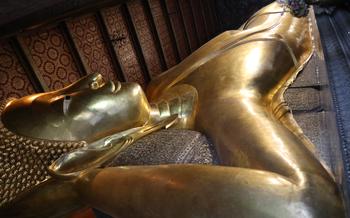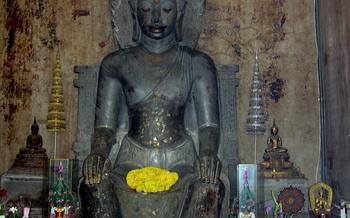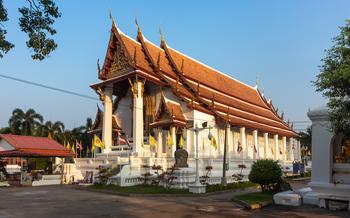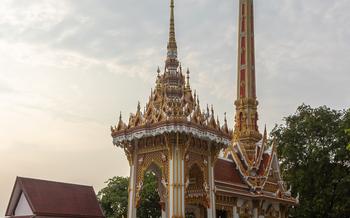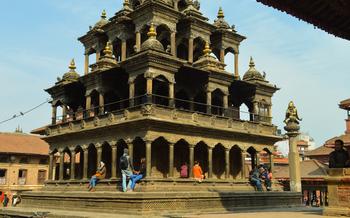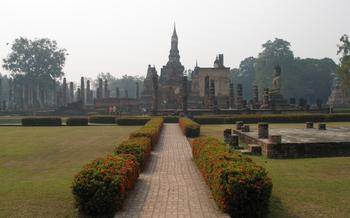
Wat Tamnak Tai
- Exploring the Temple Grounds
- The Ordination Hall (Ubosot)
- The Buddha Image of Luang Pho Phra Sai
- The Phra Mongkol Matthon Buddha Image
- Phra Maha That Buddha Image: A Symbol of Reverence and Serenity
- The Sala Karn Parien (Meditation Hall)
- The Bell Tower
- The Pond and Gardens
- Festivals and Events
- Accommodation and Dining Options
- Insider Tip:
Exploring the Temple Grounds
Wat Tamnak Tai boasts a well-preserved and intricate temple layout, showcasing traditional Thai architecture and craftsmanship. The centerpiece of the complex is the ordination hall, or ubosot, a magnificent structure adorned with intricate carvings and colorful murals. The hall houses several important Buddha images, including the highly revered Luang Pho Phra Sai, known for its miraculous powers and the subject of many local legends.
Other notable structures within the temple grounds include the reclining Buddha, known as Phra Narai Rattana Matthon, a colossal statue measuring over 15 meters in length, symbolizing the Buddha's transition into Nirvana. The Phra Mongkol Matthon Buddha Image, crafted from a single block of white marble, exudes a serene aura and is believed to have been created by divine intervention. The Phra Maha That Buddha Image, with its distinctive posture and intricate details, represents the pinnacle of craftsmanship during the Ayutthaya period.
The temple also features a stunning chedi, a tall, bell-shaped stupa, which serves as a revered symbol of Buddhism and a repository of sacred relics. Surrounding the chedi is a serene pond and lush gardens, offering a tranquil oasis amidst the temple's grandeur. Visitors can take a leisurely stroll through the gardens, enjoying the vibrant colors of tropical flowers and the gentle sound of water, creating a serene and contemplative atmosphere.
The Ordination Hall (Ubosot)
The ordination hall, also known as the Ubosot, is the most sacred building within the temple complex. It is here that monks are ordained and important ceremonies are held. The Ubosot at Wat Tamnak Tai is a beautiful example of traditional Thai architecture, with its intricate carvings and colorful murals.
The ordination hall is rectangular in shape and has a three-tiered roof. The exterior walls are decorated with intricate carvings of mythical creatures and scenes from the life of the Buddha. The interior of the hall is even more impressive, with its stunning murals and Buddha images.
The main Buddha image in the Ubosot is called Luang Pho Phra Sai. This image is highly revered by the local people and is believed to have miraculous powers. The image is made of gold and is seated in a meditation posture.
The walls of the Ubosot are covered in murals depicting scenes from Buddhist scriptures. These murals are a valuable source of information about Thai history and culture. They also provide a glimpse into the beliefs and values of the Thai people.
The Buddha Image of Luang Pho Phra Sai
Among the many revered Buddha images at Wat Tamnak Tai, one that stands out is Luang Pho Phra Sai, an ancient and highly respected image. According to local legend, the image was crafted in the Ayutthaya period and was originally enshrined at Wat Phra Phutthabat in Saraburi. However, during the reign of King Rama III, a severe flood ravaged the temple, causing the image to be swept away by the currents. Miraculously, the image was later discovered floating in the Bang Pakong River by a group of fishermen from Ban Nong Nam Daeng.
Luang Pho Phra Sai possesses unique characteristics that set it apart from other Buddha images. The image is crafted from bronze and features a serene expression with downcast eyes, a gentle smile, and a slight tilt of the head. The intricate details of the image, including the delicate folds of the robe and the meticulously carved ornaments, showcase the exceptional craftsmanship of its creators.
Devotees hold Luang Pho Phra Sai in high regard, believing that the image possesses sacred powers and the ability to grant wishes. They often offer prayers, light incense sticks, and make merit by placing gold leaves on the image as a symbol of their devotion. The image has become a focal point for religious ceremonies and special events at Wat Tamnak Tai, attracting both local residents and visitors who come to pay their respects and seek blessings.
The Phra Mongkol Matthon Buddha Image
The Phra Mongkol Matthon Buddha image, also known as the Great Buddha of Saraburi, is a colossal and awe-inspiring statue that stands as a symbol of devotion and tranquility within the Wat Tamnak Tai temple complex. Its creation was initiated by a group of devoted villagers seeking to honor the teachings of Lord Buddha and promote spiritual well-being in the community.
Measuring an impressive 22 meters in height, the Phra Mongkol Matthon Buddha image is crafted from a unique blend of cement, sand, and seashells, a testament to the ingenuity and resourcefulness of its creators. This innovative approach not only ensured the longevity and durability of the statue but also imbued it with a distinctive texture and appearance.
The image exudes an aura of serenity and compassion, with its gentle facial features and intricate detailing. The Buddha is depicted in the iconic seated posture, symbolizing his unwavering presence and steadfast teachings. The statue's grand scale and meticulous craftsmanship have earned it widespread recognition and admiration, attracting visitors from near and far who come to pay homage and seek spiritual guidance.
Phra Maha That Buddha Image: A Symbol of Reverence and Serenity
Among the many sacred images enshrined within Wat Tamnak Tai, the Phra Maha That Buddha Image holds a special place in the hearts of the local community. This colossal Buddha statue, standing tall with an aura of serenity, is a masterpiece of craftsmanship and a symbol of deep religious devotion.
The history of the Phra Maha That Buddha Image is steeped in legend and folklore. It is said that the image was originally discovered in the jungle by a group of hunters who were awestruck by its beauty and grandeur. Believing it to be a sacred object, they carefully transported it to Wat Tamnak Tai, where it has been revered ever since.
The image is a testament to the artistic skills of ancient Thai artisans. Carved from a single block of sandstone, the statue exudes an intricate level of detail that is simply breathtaking. The Buddha's serene countenance, delicate features, and graceful posture reflect the essence of Buddhist teachings, instilling a sense of peace and tranquility in all who behold it.
The Phra Maha That Buddha Image plays a pivotal role in local religious ceremonies and festivals. During special occasions, the image is adorned with elaborate floral arrangements, offerings, and incense sticks, creating a mesmerizing spectacle of devotion. The faithful gather around the statue, chanting prayers and paying homage to this sacred symbol of their faith.
The Sala Karn Parien (Meditation Hall)
The Sala Karn Parien, or meditation hall, is a serene and sacred space within Wat Tamnak Tai dedicated to the practice of meditation. This serene sanctuary provides a tranquil environment for visitors to find inner peace and connect with their spiritual side. The hall's simple yet elegant design features a spacious interior with comfortable seating arrangements, creating an atmosphere conducive to deep contemplation and mindfulness.
During your visit to the meditation hall, take a moment to sit and immerse yourself in the tranquility of the space. Close your eyes, focus on your breath, and let go of any distractions. The serene ambiance of the hall will help you to calm your mind and enter a state of deep relaxation. Whether you are a seasoned meditator or a beginner seeking a peaceful retreat, the Sala Karn Parien offers an ideal setting for introspection and spiritual growth.
The Bell Tower
The bell tower, standing tall and elegant within the temple grounds, is not merely an architectural element but also holds significant religious and cultural importance. Its design reflects traditional Thai architecture, featuring intricate carvings and a multi-tiered roof. The bell tower serves as a symbol of the temple, echoing its presence throughout the surrounding area.
The bells housed within the tower are not just decorative pieces but play a crucial role in Buddhist rituals and ceremonies. The sound of bells has long been associated with the call to prayer and meditation in Buddhist temples, serving as a reminder for devotees to focus their minds and hearts on spiritual matters. The ringing of bells is believed to carry vibrations that purify the surrounding environment and create a conducive atmosphere for religious contemplation.
During important festivals and events held at the temple, the bell tower becomes a focal point of attention. The rhythmic chiming of bells signals the commencement of ceremonies, inviting devotees to gather and participate in communal prayers and offerings. The melodious sounds reverberate through the temple grounds, creating a serene and harmonious ambiance that enhances the spiritual experience for all present.
The Pond and Gardens
The serene beauty of the pond and gardens at Wat Tamnak Tai adds to the tranquility of the temple grounds. The pond, with its crystal-clear waters, reflects the surrounding lush greenery and the golden spires of the temple, creating a picturesque landscape. Visitors can find solace as they sit by the pond, listening to the gentle sound of water and admiring the colorful lotus flowers that bloom in abundance. The gardens, meticulously landscaped with a variety of tropical plants and flowers, provide a tranquil oasis for visitors to wander and enjoy the beauty of nature. The gardens are designed to evoke a sense of serenity and contemplation, inviting visitors to slow down and appreciate the present moment.
Festivals and Events
Wat Tamnak Tai is not only a place of worship but also a vibrant center for cultural events and celebrations. Throughout the year, the temple hosts various festivals and special events that attract both locals and visitors alike. One of the most significant events is the annual temple fair, held during the Songkran festival in April. During this time, the temple grounds come alive with colorful processions, traditional Thai music and dance performances, and a lively market filled with local delicacies, handicrafts, and souvenirs. Visitors can immerse themselves in the festive atmosphere, experience Thai culture firsthand, and take part in the merit-making activities that are central to the Songkran celebrations. Other notable events include the Kathin ceremony, where new robes are offered to the monks, and the Makha Bucha festival, which commemorates the day when Buddha delivered his first sermon to his disciples. These events provide a glimpse into the deep-rooted Buddhist traditions and beliefs that are still practiced in Thailand today.
Accommodation and Dining Options
When planning a trip to Wat Tamnak Tai, visitors have various accommodation options to choose from. Numerous hotels, guesthouses, and resorts are located within Saraburi and the surrounding areas, catering to different budgets and preferences. For a truly immersive experience, consider staying in a traditional Thai-style guesthouse or a riverside resort, offering picturesque views and easy access to local attractions.
For dining, Saraburi offers a delightful culinary scene with a diverse range of restaurants and eateries. Indulge in the authentic flavors of Thai cuisine, renowned for its vibrant spices and fresh ingredients. Sample local delicacies such as Som Tum (papaya salad), Khao Neeo Mamuang (sticky rice with mango), and Gaeng Daeng (red curry) at local restaurants or street food stalls. For a memorable dining experience, head to one of the many riverside restaurants, where you can enjoy delicious food while taking in the stunning views of the river and the surrounding countryside.
Insider Tip:
To fully immerse yourself in the serenity of Wat Tamnak Tai, plan your visit during the early morning hours or late afternoon when the crowds are typically smaller. This will allow you to wander through the temple grounds at your leisure, soak in the tranquil atmosphere, and capture stunning photographs without distractions.
When visiting sacred religious sites like Wat Tamnak Tai, it's essential to dress appropriately out of respect for local customs. Opt for modest attire that covers your shoulders and knees. Remember to remove your shoes before entering any of the temple buildings, as is customary in Buddhist temples.
Finally, don't miss the opportunity to capture the beauty of Wat Tamnak Tai through photography. The intricate architecture, serene gardens, and majestic Buddha images offer endless photogenic moments. Take your time to explore different angles and lighting conditions to create stunning memories of your visit.

